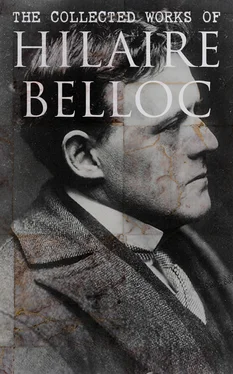The reader must carefully distinguish between the acceptation by the Church of a detail of economic reform, the consent to suppress a corporation at the request of the civil power, or even to forego certain traditional political rights, and the admission of the general principle of civil control. To that general principle the Assembly, in framing the Constitution of the Clergy, was quite evidently committed. To admit such a co-ordinate external and civil power, or rather to admit a superior external power, is in theory to deny the principle of Catholicism, and in practice to make of the Catholic Church what the other State religions of Christendom have become.
I have said that not until the end of the year 1790 was the debate opened upon the proposition to compel the clergy to take the oath.
It is a singular commentary upon the whole affair that compulsion should have been the subject for debate at all. It should have followed, one would have imagined, normally from the law. But so exceptional had been the action of the Assembly and, as they now were beginning to find, so perilous, that a special decree was necessary—and the King's signature to it—before this normal consequence of a measure which had been law for months, could be acted upon.
Here let the reader pause and consider with what that moment—the end of 1790—coincided.
The assignats, paper-money issued upon the security of the confiscated estates of the Church, had already depreciated 10 per cent. Those who had first accepted them were paying throughout France a penny in the livre, or as we may put it, a penny farthing on the shilling, for what must have seemed to most of them the obstinacy of one single corporation—and that an unpopular one—against the decrees of the National Assembly.
It was now the moment when a definite reaction against the Revolution was first taking shape, and when the populace was first beginning uneasily to have suspicion of it; it was the moment when the Court was beginning to negotiate for flight; it was the moment when (though the populace did not know it) Mirabeau was advising the King with all his might to seize upon the enforcement of the priests' oath as an opportunity for civil war.
The whole air of that winter was charged with doubt and mystery: in the minds of all who had enthusiastically followed the march of the Revolution, the short days of that rigorous cold of 1790–91 contained passages of despair, and a very brief period was to suffice for making the clerical oath not only the test of democracy against reaction, but the wedge that should split the nation in two.
With the very opening of the new year, on the 4th of January, the bishops and priests in the Assembly were summoned to take the oath to the King, the Nation, and the Law; but that law included the Civil Constitution of the Clergy, and they refused. Within three months Mirabeau was dead, the flight of the King determined on, the suspicion of Paris at white heat, the oath taken or refused throughout France, and the schismatic priests introduced into their parishes—it may be imagined with what a clamour and with how many village quarrels! In that same fortnight appeared the papal brief, long delayed, and known as the Brief " Caritas ," denouncing the Civil Constitution of the Clergy. Six weeks later, at the end of May, the papal representative at the French Court was withdrawn, and in that act religious war declared.
Throughout this quarrel, which was now exactly of a year's duration, but the acute phase of which had lasted only six months, every act of either party to it necessarily tended to make the conflict more violent. Not only was there no opportunity for conciliation, but in the very nature of things the most moderate counsel had to range itself on one side or the other, and every public act which touched in any way upon the sore point, though it touched but indirectly, and with no desire on the part of the actors to rouse the passions of the moment, immediately appeared as a provocation upon one side or the other.
It was inevitable that it should be so, with a population which had abandoned the practice of religion, with the attachment of the clerical organisation to the organisation of the old régime , with the strict bond of discipline that united the priesthood of the Church in France into one whole, and above all with the necessity under which the Revolution was, at this stage, of finding a definite and tangible enemy.
This last point is of the very first importance. Public opinion was exasperated and inflamed, for the King was known to be an opponent of the democratic movement; yet he signed the bills and could not be overtly attacked. The Queen was known to be a violent opponent of it; but she did not actually govern. The Governments of Europe were known to be opponents; but no diplomatic note had yet appeared of which public opinion could make an object for attack.
The resistance, therefore, offered by the clergy to the Civil Constitution, had just that effect which a nucleus will have in the crystallisation of some solution. It polarised the energies of the Revolution, it provided a definite foil, a definite negative, a definite counterpoint, a definite butt. Here was a simple issue. Men wearing a special uniform, pursuing known functions, performing a known part in society—to wit, the priests—were now for the most part the enemies of the new democratic Constitution that was in preparation. They would not take the oath of loyalty to it: they were everywhere in secret rebellion against it and, where they were dispossessed of their cures, in open rebellion. The clergy, therefore, that is the non-juring clergy (and the conforming clergy were an experiment that soon became a fiction), were after April 1791, in the eyes of all the democrats of the time, the plainest and most tangible form of the opposition to democracy.
To the way in which I have presented the problem a great deal more might be added. The very fact that the democratic movement had come after a period of unfaith, and was non-Catholic in its springs, would have tended to produce that quarrel. So would the necessary attachment of the Catholic to authority and the easy confusion between the principle of authority and claims of a traditional monarchy. Again, the elements of vanity, of material greed, and of a false finality which are to be discovered in any purely democratic theory of the State, will between them always bring this theory into some conflict with religion. The centuries during which the throne and the altar had stood as twin symbols, especially in France, the very terminology of religious metaphor which had been forged during the centuries of monarchical institutions in Europe, helped to found the great quarrel. But, I repeat, the overt act without which the quarrel could never have become the terribly great thing it did, the master blunder which destroyed the unity of the revolutionary movement, was the Civil Constitution of the Clergy.
So much for the first year of the schism, May 1790 to May 1791. The second year is but an intensification of the process apparent in the first.
It opens with the King's flight in June 1791: that is, with the first open act of enmity taken against the authority of the National Parliament since, two years before, the National Parliament had declared itself supreme. Already the Court had been generally identified with the resistance of the clergy, and a particular example of this had appeared in the opinion that the King's attempted journey to St. Cloud in April had been prompted by a desire to have communion at the hands of a non-juring priest. 8When, therefore, the King fled, though his flight had nothing whatsoever to do with the clerical quarrel, it was associated in men's minds with the clerical quarrel through his attempt to leave Paris in April and from a long association of the Court with the clerical resistance. The outburst of anti-monarchical feeling which followed the flight was at the same time an outburst of anti-clerical feeling; but the clergy were everywhere and could be attacked everywhere. The Declaration of Pillnitz, which the nation very rightly interpreted as the beginning of an armed European advance against the French democracy, was felt to be a threat not only in favour of the King but in favour also of the rebellious ecclesiastics.
Читать дальше












